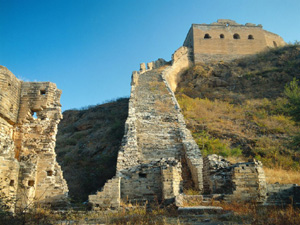The wall, unplugged
 0 Comment(s)
0 Comment(s) Print
Print E-mail
Greatwall-of-china.com, May 19, 2008
E-mail
Greatwall-of-china.com, May 19, 2008

Considering that it was constructed for the purpose of keeping foreigners out of China, it's ironic that the Great Wall has become China's number one attraction for visitors from abroad.
If you've only done the chairlift at Badaling, however, you can hardly count yourself as a Wall veteran. Indeed, speak to any tourist visiting Beijing, and you may well get the impression that there are only three parts of the Great Wall to be seen in the country. Backpackers are especially quick to make fun of the Badaling and Mutianyu crowd, and speak in hushed tones of the "real" wall at Simatai.
Let's be honest - all three of these sections are intensely marketed to tourists of varying persuasions - and while all of them are fine parts of the Wall to see, on a monument with sections scattered across the country there is certainly a lot more ground to be covered.
We may no longer be able to follow in the steps of William Lindesay - the Briton who journeyed the entire length of the Wall on foot in 1987 - but there are still numerous locations within reach of Beijing where visitors can enjoy features and designs unique to each particular section.
If you want to be able to stay a step ahead of those backpackers who assume they've seen more of China than you have just because they've climbed some stairs at Simatai, take a day off to see some of the less-travelled Wall and give yourself something really worth boasting about.
Don't forget that much of the Great Wall in this part of the country climbs near-vertical mountain faces, so if the only exercise you've been doing is thumbing through boxes of DVDs, gird yourself to expend some effort. The Wall sections in most of these locales are rough staircases up mountainsides. The climb, however, is more than worth the effort.
If you're making a weekend of it, you'll usually be able to find a local farmer with a room to rent - they're used to tourists coming knocking. In Xifengkou, however, you'll need to go back to Qianxi to find a hotel, and in Jiumenkou and Laolongtou, head for the walled city of Shanhaiguan to spend the night.
The Great Wall at Jiankou
Jiankou is hiking Wall, where you'll be clambering over fallen brick and inching your way up steep un-railed mountain faces - take care. The white cliff rock used in its construction makes Jiankou stand out strikingly against the heavily forested hillsides, making it one of the most photogenic Wall sections. You can camp out for the night in one of the towers -but don't forget to take sufficient drinking water with you.
The Great Wall at Huanghuacheng
Overgrown with sweet yellow flowers in the summer and stretching high above a natural spring lake and crescent-shaped water reservoir, this is a beautifully preserved section of the Wall favored by nature lovers all year round. That being said, the paths are far from pristine - this is 420-year-old masonry - but the climb isn't steep until you get higher up, and in some parts the walk is very pleasant.
The Great Wall at Huangyaguan
The Huangyaguan Wall in Tianjin features some unusual architecture and unique watchtower design, the result of strategic imperatives. This was an important pass that required superb defence facilities, and the small city built below (now refitted to accommodate tourists) was fixed with traps and wrong-turns to confuse any invaders who made it through. It's a tough section of the Wall, noted for its peculiarly austere beauty and mathematically precise nature.
The Great Wall at Xifengkou
Characterized by almost obliterated Wall stretches that lie between curiously well-preserved watchtowers, Xifengkou is most famous for a submerged section - depending on reservoir levels, the underwater Wall can be seen as a ghostly silhouette of ancient glories. The Nationalists found this pass as strategically valuable as ever when staging successful resistance attacks here against the Japanese in 1933 - if you look carefully, you can still find bullet holes in the Wall.
The Great Wall at Jiumenkou
The Jiumenkou Wall near Liaoning's Huludao is known for its 100m span across the Jiujiang river - the only part of the Great Wall that resembles, and functions as, a bridge - with nine sluice gates making up the pass across the river. There are two kilometers of easy going and fully restored Wall here to explore, making for a nice afternoon¡¯s climb. This is an easy part of the Wall to conquer.
The Great Wall at Laolongtou
The Great Wall finally meets the sea at Laolongtou - the head of the Wall. This is a level and fully reconstructed section that extends from the beach all the way back to the walled city of Shanhaiguan and straight up the steep slopes of Jiaoshan Mountain.
Go to Forum >>0 Comment(s)